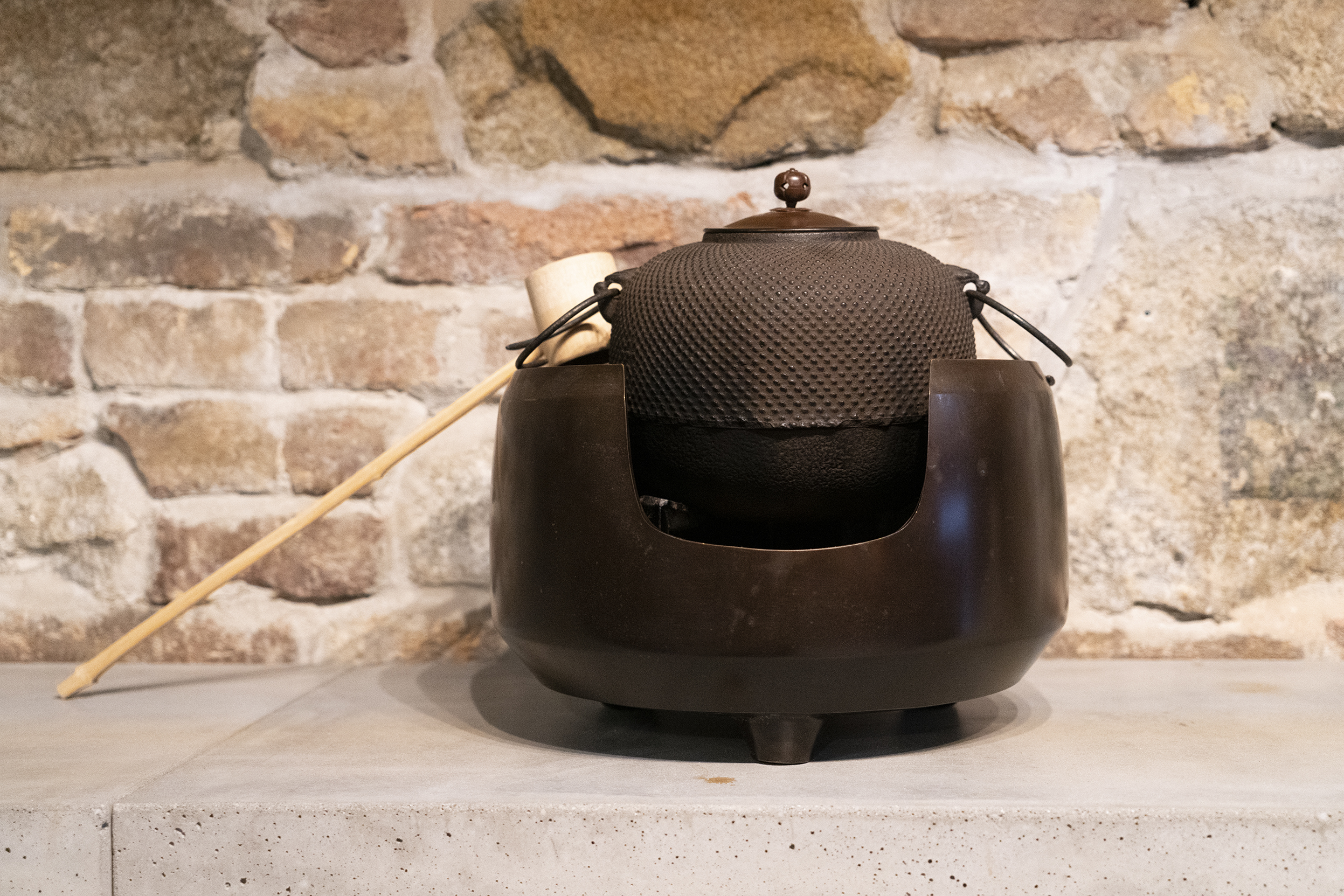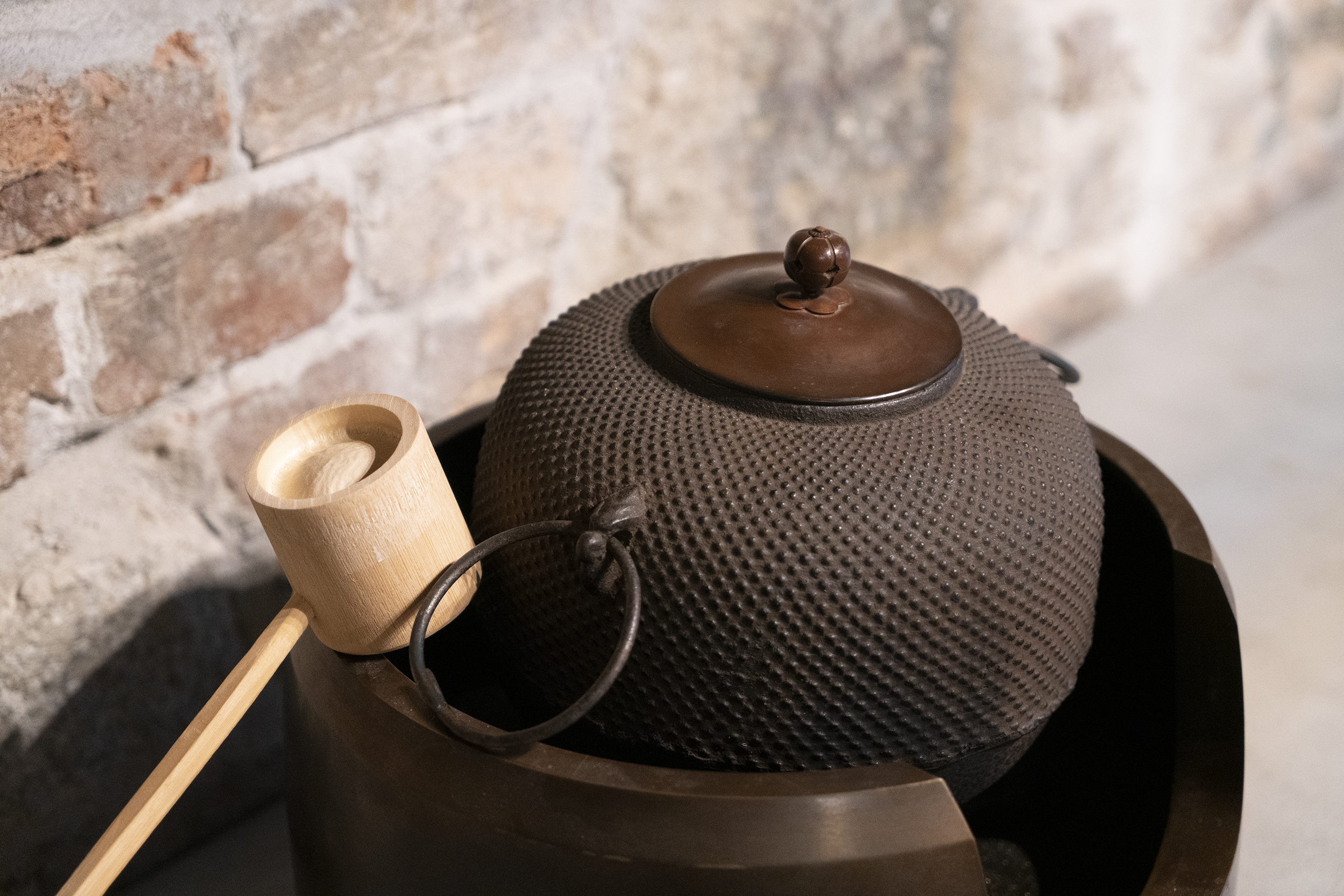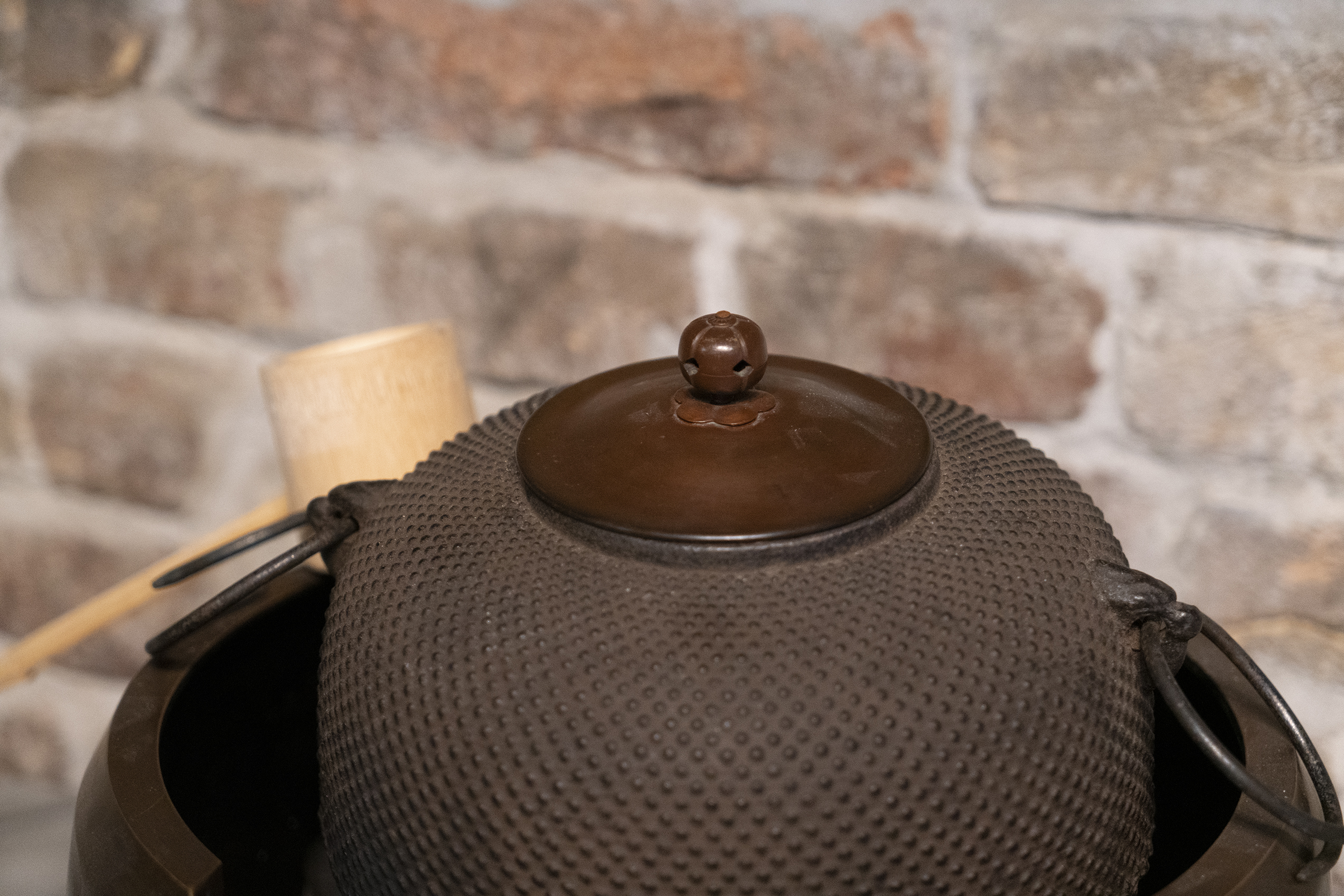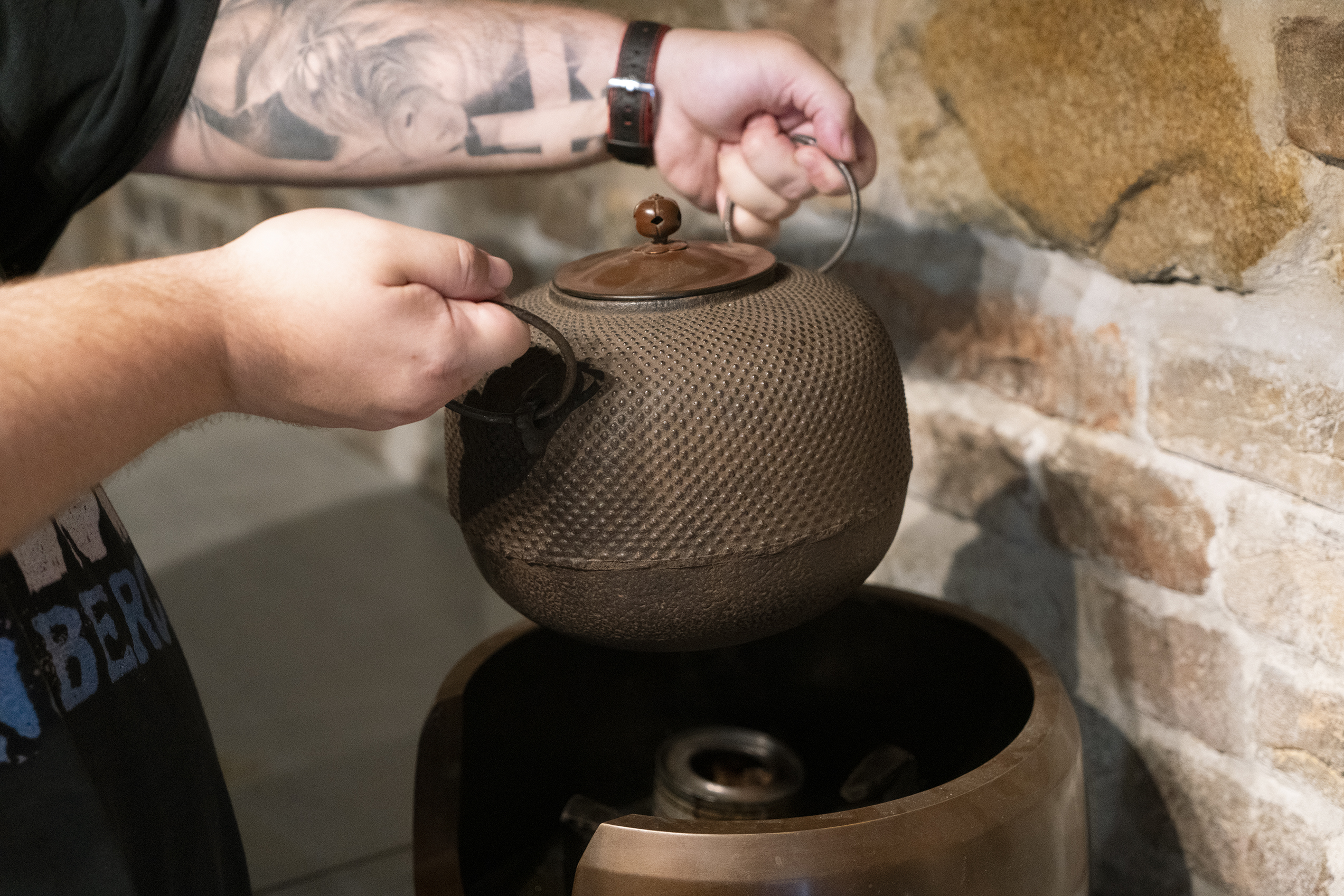Close Things / RICHARD GLASNER
Richard’s close thing came from a great distance – from Japan. The chagama, the magnificent vessel used to heat water during the Japanese tea ceremony, is just one part of a complex ritual in which everything means something, and which is part of an immensely fascinating culture.
What’s the story behind the close thing you chose?
It started in a tea room where I used to work as a part-time employee twenty years ago. And there was a constant rumour going around about what couldn’t be done at a tea ceremony. Simply that you can’t completely reproduce the Japanese tea ceremony in Slovakia because you won’t have everything. Because, for example, a chagama (a large metal vessel for heating water) simply cannot be imported, even more so when it’s a historic, cast-iron, incredibly heavy thing. And there was a story told in the tea room that when the translator (and also a great Japanophile) Mrs Čarnogurská was in Japan in the 1990s, a colleague of hers, who also travelled there, was the only one in history to bring a chagama to Slovakia – and that only because he left all his things there. He simply gave up everything he had with him, his clothes, his suitcase… he gave up everything to take that one thing. So the chagama became for me at that time such a symbol of what cannot be.
And now, 20 years later, when I was planning to open a tea shop, I realized that I have what I thought was impossible for so long – a historic chagama.
As such, the chagama is used to heat the water before the tea ceremony. And even though I had already acquired it, I had to gradually look for ways to use it in our conditions. In Japan, they like to use spring water. And I boiled Fatra plus in mine twice (laughs), which created a layer of scale and so prevented the inside from rusting. And then there’s the other thing – what to heat it with underneath. The Japanese use ash for that. They heat with coal in their houses, so it makes sense. But I can’t use it here because any coal can be smelled in the air. In the end, I found that the ideal way is alcohol.
So how did you choose your chagama? It must have been almost like someone deciding on a life partner.
Yes, it’s a long-term thing. I chose for a long time, but in the end it was quite intuitive and spontaneous. I saw it and I knew it was the one.
Do you know how old it is?
I know and I don’t know. The Japanese judge the age of things in such a strange way. There’s the new ones, then there’s the long, long nothing, and then there’s the antiques. I compare it to the porcelain bowls I used to buy for drinking or even other soup bowls, made of lacquered wood. And when I was buying them, I used to ask how old they were. The salesman’s answer was: it’s not very old, it’s about a hundred, a hundred and fifty years old. This chagama should be about 120 years old. But that’s relatively new from their point of view.
Now, I want to mention here that the Japanese flea beetles were the best flea beetles I’ve ever experienced. You can find everything from samurai armor to tea bowls. But that armor is about 400 years old, and the value is appropriate for the age…often approaching the value of the house. So on the same flea market you’ll find a bowl for five Euros and such armor at the price of real estate.
Japan to me is a country of incredible contrasts. And until now, I haven’t been able to define for myself the feeling of whether the country is modern or historical, because the contrast is in everything. On one street, skyscrapers alternate with ancient shrines. And the most scifi experience are always the toilets.
I also notice the contrast in the chagama itself, this bottom ” shell ” looks very modern, even futuristic to me, and on the contrary, the inside looks quite old. You mentioned that you bought it online, so you couldn’t feel it properly before. How did it feel when it finally arrived?
I was really looking forward to it, but it was frustrating at the same time, because it was so frustrating to work with Slovak customs… And it was also hard not to tell my partner what we were going for, because it was going to be a surprise for her as well. And I don’t drive, so she had to drive me to that customs. So I just hoped she wouldn’t read the name on the box, since she speaks Japanese. Luckily, there was nothing on the box. It was a whole exhausting process, but I was very excited about it, and so far I am. It’s a thing I didn’t even think I’d have one day. Such a childhood fantasy, like someone wanting to be an astronaut. It’s like I finally got to sit in a rocket. Of course, it’s not the final life goal. But there are some things you don’t aspire to because it’s almost fanciful at some point, unattainable. And then there comes a moment when you suddenly hold it in your hands.


How does such a traditional Japanese tea ceremony happen? When does chagama enter into it?
It actually only serves to heat the water. The whole thing is you take a chawan, which is a tea bowl, you scoop the matcha into it, boil the water, pour it in, and whisk it.
So the tea ceremony is only done with matcha?
No, there is also a tea ceremony for sencha, but the one we know is with matcha. There are different tea ceremonies, and in China they still have completely different ones of their own. This one is called chado, and it’s a traditional tea ceremony with matcha.
There are three schools in Japan that do this, and each one does the ceremony a little differently. And those differences lie in such subtle things as the preferred type of bamboo used to make some of the things used in the ceremony. And the members of each of those schools are very convinced that they are the true successors of the tea ceremony. The schools are called Urasenke, Omotesenke, Mushakōjisenke …. They are named after the three rooms of the house where the original tea master, Sen, and his family once lived.
Omotesenke has historically been a very expensive ceremony for the upper class, and conversely Urasenke is open to all. Well, sometimes what happens is that someone modernizes something within the ceremony and everyone grabs their heads…that how could that happen.
And they convince each other who is the best, that this particular school has understood the master the best (laughs). But when you look at it closely and you cleanse the names of that kind of tea party “mythology”, it’s inherently very funny.
How would you describe the different parts of the tea ceremony?
It has a lot of interesting little details. For example, the entrance to the hut is lowered so everyone has to bend down. The different steps that the tea ceremony has are incredibly many. And every single step, movement, like the way the tea master turns around, represents something. For example, such as loading the chagama with ash – there are good YouTube videos for this – so one does this for 30 minutes, at real speed. And that’s just loading the ash. He’s levelling it, smoothing it. But for the master, it’s actually like an inner meditation, he has no audience, no clients. So he prepares it like this, then twice a day he makes tea.
Tea ceremonies last from 20-30 minutes to several hours. It’s a super experience. The one I was at was conducted by a lady of about 80 years old. It was incredible to watch her, in her advanced age, lift herself off the ground gracefully and with ease, wearing a kimono and with bowls in hand. The owner of the shop where this was happening was in the business of selling vintage pottery. And he had a shelf of chawan that everyone could choose from. And when you drank from it, they told you that it was, by the way, by such and such a master, and that you had chosen well, because it was very rare, and if you wanted to buy it, it was going for around 10,000 euros at auction.
Those people were perfect. When we left, the shop owner drew us each a chavan to drink from. And he gave us the drawing as a memento.
It’s also interesting that they don’t tip in Japan, they consider it rude. But what is not a problem is to give a small gift. That’s why we brought Slovak honey with us. The Japanese like honey and the most common there is acacia honey. We brought mountain honey, and when we left it there after the tea ceremony, as a gift, it was quite a show. They were very excited about it. The owner’s wife asked us how we used to consume such honey in Slovakia, if there was any special approach to it. I was ashamed to say that we were just having it as a normal Christmas treat (laughs). Gradually the whole family ran there, and the old lady almost cried. And then somebody says that the Japanese are heartless and in hindsight – not at all.
Back to the ceremony: another interesting thing is that those chawan, the drinking bowls during the tea ceremony, are always supposed to have some kind of flaw.
And this is meant to be in line with their wabi-sabi philosophy?
Yes. If one is into Zen Buddhism, there’s a parallel, it’s called distraction meditation. It consists of looking at an object and admiring its perfection through that imperfection. But even that has very peculiar rules. For example, that such a bowl has to be turned three and a half times. You turn the chawan in your hands exactly three and a half times, you admire it like that, and then you can drink from it. I like their almost absolute traditionalism.
Coming back to the tea ceremony – what is its history within the society? Was this ritual once a part of every household? A family tradition that was passed down from generation to generation?
No. It has only ever worked within the schools I mentioned. There are many people in Japan who have never seen the tea ceremony. But then again, there aren’t people there who don’t drink tea. There’s sencha, gyokuro, and matcha, the more noble teas, and then on the other side there are these everyday ones, and of those they drink bancha the most, usually after meals. Everywhere you go, you get a cup of tea. But then it’s not connected with any ceremony. The tea ceremony is such a narrow thing-maybe like us knowing how to dance the odzemok, if I had to compare. And it has to be said that Japan is a huge country in terms of people, they have 125 million inhabitants. So even if there are 10,000 such professional masters, it’s like a drop in the ocean. But they have the advantage that they really take care of this cultural heritage. They value their own history and they are very cordial to people who show respect for their history. Back then, they would carry you on their hands. Japan is a very contradictory country, the extremes are unbelievable. But beautiful. Probably the most beautiful I’ve ever been to.
